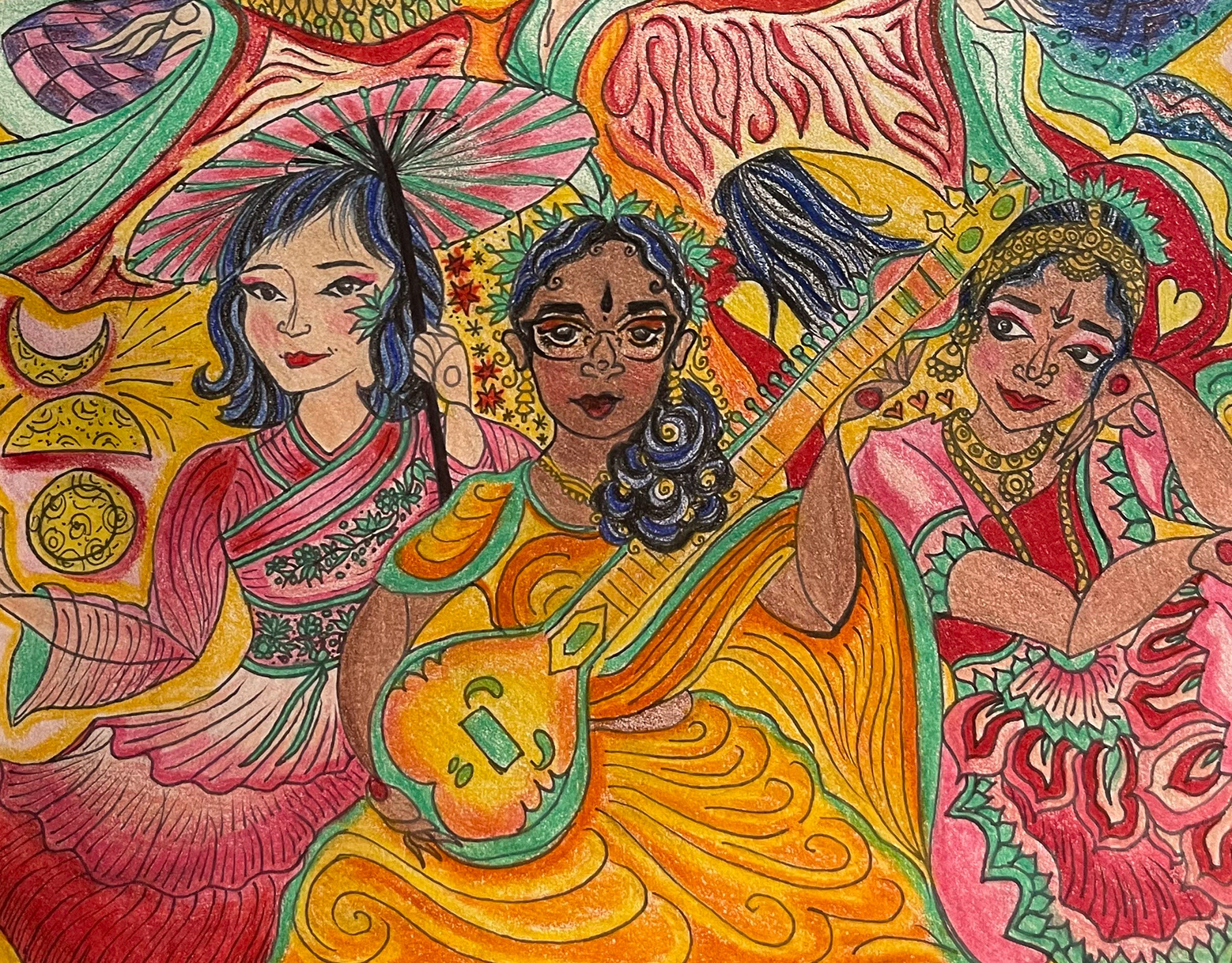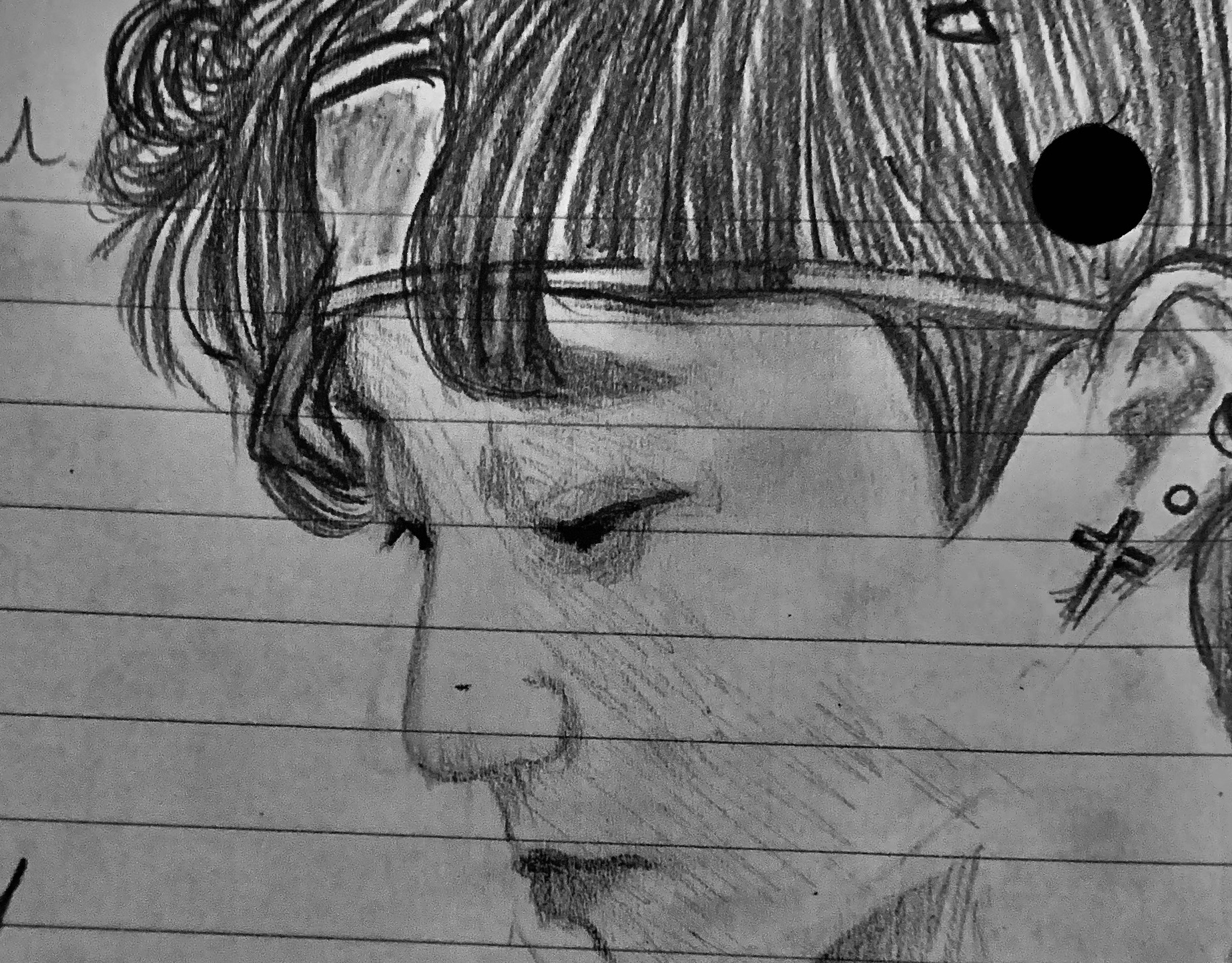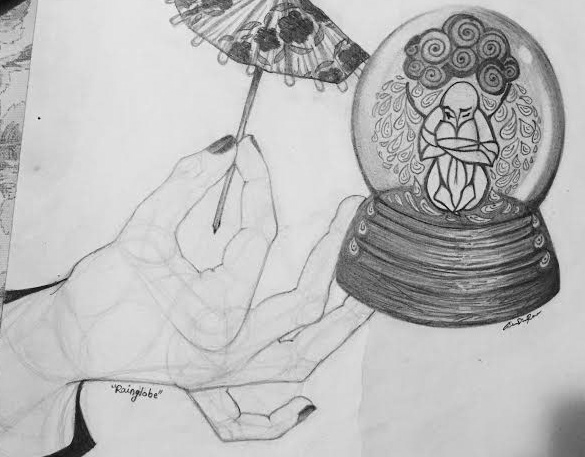"Crescent Woman" (2014)
Watercolor pencil and ink painting of a woman, inspired by traditional African masks and South Indian Tamil style bottus (spiritual third eyes and marks of which Hindu deity one worships). This features the artist's love for finding and bringing out symmetry with geometric shapes in human faces, namely focusing on crescent, circular, and triangular shapes. Style is also influenced by Bapu, a South Indian Telugu artist who worked with bold colors and continuous lines.
More from this Category:

“Indo-Chinese Classical Dance" (2024)
Drawn with colored pencil and ink based on ink outline (see "Draft" in Poster section of portfolio). Each dancer is based on reference photographs of traditional Chinese classical dance costumes and traditional Indian classical dance/music costumes (Bharatanatyam, Odissi, Carnatic). Motifs associated with each culture, including a parasol and a sitar, are included. A bold, gradient color scheme which suits both cultures was applied to the clothing, hair, and backdrop. Each figure's costume, makeup, hairstyle, and accessories is distinct. Figures are arranged and layered on the poster to show people sharing classical arts and cultural spaces with each other. Motifs of the moon and the stages of love, which was the showcase theme, is included to the bottom left (moon phases) and bottom right (small hearts). Symmetry and balance was achieved by keeping figures in parallel poses and parallel colors. Finally, the cursive script used for the description stands in contrast with the showcase information, title, and the dance clubs' names (Mei-Kala). A bold, curved script was used to match the curves and angles of the performers' bodies.

“Beomgyu” (2019)
Freehand sketch with pencil. This illustration is of Beomgyu, a Korean pop idol from the band, "TXT (Tomorrow by Together)". The aim of this piece was to practice drawing a three-fourths profile of a male subject. Focus was kept on bringing out the eyelashes, subtle lips, and hair. This was drawn in a realistic style, to test the artist's ability to capture a subject quickly.

"Rainglobe: Trapped Angel" (2016)
Illustrated with pencil for a Drawing class assignment, in which students were instructed to create a piece that incorporated a hand, an object, and glass. Thus, this illustration is of a small, isolated, angelic figure trapped in a globe. A raincloud in the globe showers onto them, and the feathery drops turn into wings. Hence, the title of the piece. Meanwhile, outsiders attempt to offer comfort, represented by a hand holding a cocktail umbrella up to the glass. However, their efforts are futile; the figure is beyond their reach, and it will take more than a frail umbrella to shatter the glass. The figure, drafted in the second image below (you'll see it when you scroll down), has wrapped their limbs into a near-fetal position. They peek out at the hand, at the comfort being offered, but do not engage with it. Note the use of shading in the glass and wooden base of the globe, the high contrast of the figure's outline, a spot of light upon the glass, and the mechanical drawing style of the hand which breaks it into its simplest forms.

Pitchdeck Samples pt. 1 (2024)
CUSTOMER REVIEW: "Excellent, much more vivid [than company's previous pitchdeck].” Pitchdeck for potential investors, designed using Google Slides, for Bloqcube Inc., a pharma-tech start-up. Integrated logo by breaking cube into bars with arrow motif to represent forward-thinking solutions and the secure movement of patient data via blockchain. Created patterns from logo to fill space when needed.

"Chitrakootha Forest Romance" (2023)
Drawn with ink. Figure on the left is a Hindu goddess, Sita Devi, daughter of the earth. Figure on the right is Sri Rama, the Hindu god of the epic "Ramayana." Here, in the Chitrakootha forest, we see Sita playfully stealing Rama's quiver of arrows and twirling one arrow out of Rama's grasp. Rama holds Sita's waist and shoulders his bow. Intricate linework shows the movement of the arrow, leaves and flowers stitched into Sita's skirt, jewelry, and crown, and lotus flowers in Rama's pants. He wears a thread and prayer beads around his body, and the fabric tied around his waist shows his sweeping movement towards Sita. The marks of divinity are on Sita and Rama's foreheads; they are surrounded with halos and hearts. Thicker lines outline key features of their bodies, and their hair is elaborately styled. The thin, simple bowstring is meant to contrast with the details of their garments. Their feet and faces are drawn stylistically, to show loving gazes and surreal beauty.

“Ovarian Cancer Research Poster” (2020)
Designed for American Association of Cancer Research (AACR)'s Poster Session on Cancer Genomics, commissioned by Dr. Kavitha Advikolanu. Title: "Evaluation of genomic instability, ploidy status, and P53 expression in archival paraffin-embedded tissue from primary ovarian cancer specimens." Poster (including Schematic Summary flowchart, Immunohistochemical and Flow cytometry pie charts, bar graphs, scans, and tables) created using Microsoft Powerpoint, Excel. Organized with goal of organizing 12+ sections of the research paper into several flows via box alignments, along with laying out graphics and scans in equal proportion. Each section is condensed, taken from Dr. Advikolanu's research paper of the same title.

"Crescent-Swing, Smoke-Clouds" (2016)
Drawn with ink. This sketch shows a slender hand holding a cigarette, and the illusions inside the smoke cloud. There are two eyes, fanning out like wings, and multiple crescent shapes are present. One crescent holds a ladder which pours down towards a figure, reaching out to climb it. Another crescent holds a swing, while yet another serves as a bed. A crescent ship with a figure on top sits next to an ocean. A crescent swings beneath the ship in the form of an anchor. The last hidden crescents are in the bindi/bottu of the face and in the eyes themselves to mark a line of symmetry. Finally, a face peers from behind at the cloud and the smoker. The style was meant to be surreal, dreamy, yet frazzled. The figures are inspired by Warli folk art from the Indian state of Maharashtra.

"The Suicide Pact" by Dr. Advikolanu Muralidhar (2021)
Book cover and jacket designed using Adobe Illustrator for "The Suicide Pact," an English play by Dr. Advikolanu Muralidhar, a South Indian Telugu poet and writer. The central lesson is highlighted on the back cover. Each element from the set design and the themes/events themselves are illustrated. The play centers on a professor and his artistic wife, Lalitha, who despise one another, themselves, and their lives. One night, they draft a suicide pact. Since the play occurs over one night, the book spine, and the book cover's ceiling fan contains a single moon. The ceiling fan, with a sari and tie hanging from it, implies potential death looming over the characters' heads. The eye in the fan represents the audience bearing witness, who ultimately decide the story's conclusion. One line from the fan spirals into two, connecting to "U" and "I" to symbolize individuals, once united in love, now estranged. The wall has several symbols: There are two portraits of a hanging, one with and one without the head attached, to show both potential conclusions to the story. There is Lalitha's scribble next to the hangings, as she laments the meaninglessness of art and art critique. A sketch of a mother and child is drawn by Lalitha yet slashed to show her lost dream of motherhood. A question mark and quotation marks show how the majority of the play is dialogue with existential questions. The quotation marks also hint at the professor's monologue about the pointlessness of speech. A cage from the set design provides a feeling of being trapped in marriage/life. Cigarettes, a watch, a fountain pen, bangles, an ashtray and the suicide pact itself, are laid out on a table. The mangalsutra (wedding necklace) lies discarded, to show the dissolvement of marital bonds. The professor's glasses are cracked, to show distorted perspectives. The table doubles as the Bombay apartment where the characters reside, with shattered windows on one side and windows with the words "You, Me" scribbled on in Telugu. "You, me" is a phrase repeated when the characters are in love, yet those words change their meaning that night. The last letter of "Me" and the first letter of "You" are the same in Telugu, hence they merge initially (to symbolize unity in love) and gradually separate and reflect (to symbolize distortion of the self and separation in marriage) on the apartment and on the back cover's lower border.

"Indo-Chinese Classical Dance: Draft" (2024)
Drawn with ink. Each dancer is based on reference photographs of traditional Chinese classical dance costumes and traditional Indian classical dance/music costumes (Bharatanatyam, Odissi, Carnatic). Motifs associated with each culture, including a parasol and a sitar, are included. Each figure's costume, makeup, hairstyle, and accessories is distinct. Figures are arranged and layered on the poster to show people sharing classical arts and cultural spaces with each other. Motifs of the moon and the stages of love, which was the showcase theme, is included to the bottom left (moon phases) and bottom right (small hearts). Symmetry and balance was achieved by keeping figures in parallel poses and parallel colors. Finally, the cursive script used for the description stands in contrast with the showcase information, title, and the dance clubs' names (Mei-Kala). A bold, curved script was used to match the curves and angles of the performers' bodies. See "Indo-Chinese Classical Dance" (2024) to see final version of this poster.

"Fall of Free Expression" (2015)
Watercolor and ink painting depicting the threat to freedom of expression in the world, in society, in culture, and under oppressive governments. This freedom is crumbling and reflected in the shadows of vulnerable, multicolored dominoes. This piece demonstrates use of a vanishing point beyond the page.